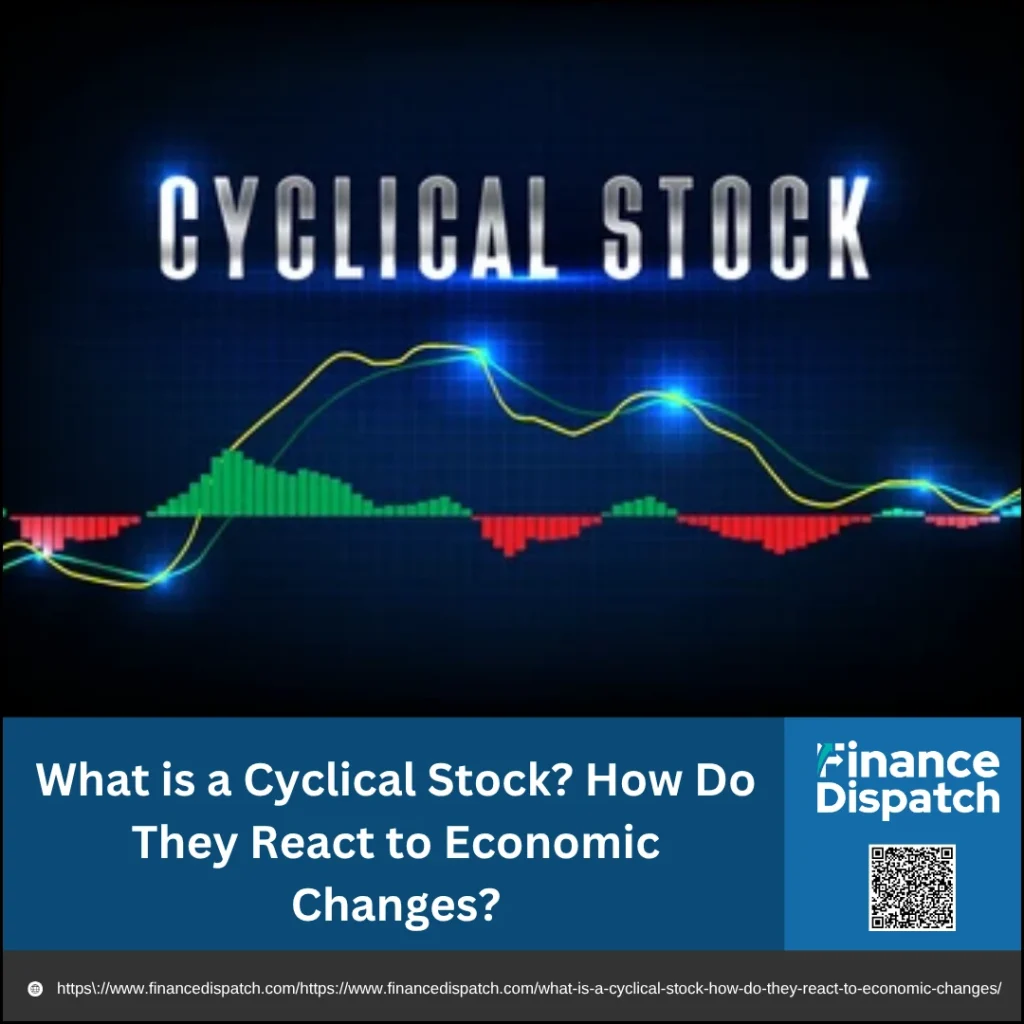In the world of investing, not all stocks behave the same way during economic ups and downs. Some surge when the economy is thriving and shrink when it falters—these are known as cyclical stocks. Their performance is closely tied to the business cycle, making them a powerful, yet sometimes unpredictable, component of an investment portfolio. Whether it’s the rise in car sales during a boom or a drop in travel bookings during a recession, cyclical stocks mirror consumer confidence and broader economic trends. In this article, we’ll explore what cyclical stocks are, the types of companies that fall into this category, and—most importantly—how they respond during different phases of the economic cycle.
What Are Cyclical Stocks?
Cyclical stocks are shares of companies whose financial performance—and therefore stock prices—rise and fall in line with the broader economic cycle. These companies typically operate in industries that sell non-essential or discretionary goods and services, such as automobiles, luxury items, travel, construction, and entertainment. When the economy is strong and consumer confidence is high, people tend to spend more on these products, boosting company revenues and driving stock prices upward. However, during economic downturns or recessions, consumers often cut back on discretionary spending, leading to reduced earnings and falling stock values. This sensitivity to economic conditions makes cyclical stocks both attractive for growth during expansions and risky during contractions.
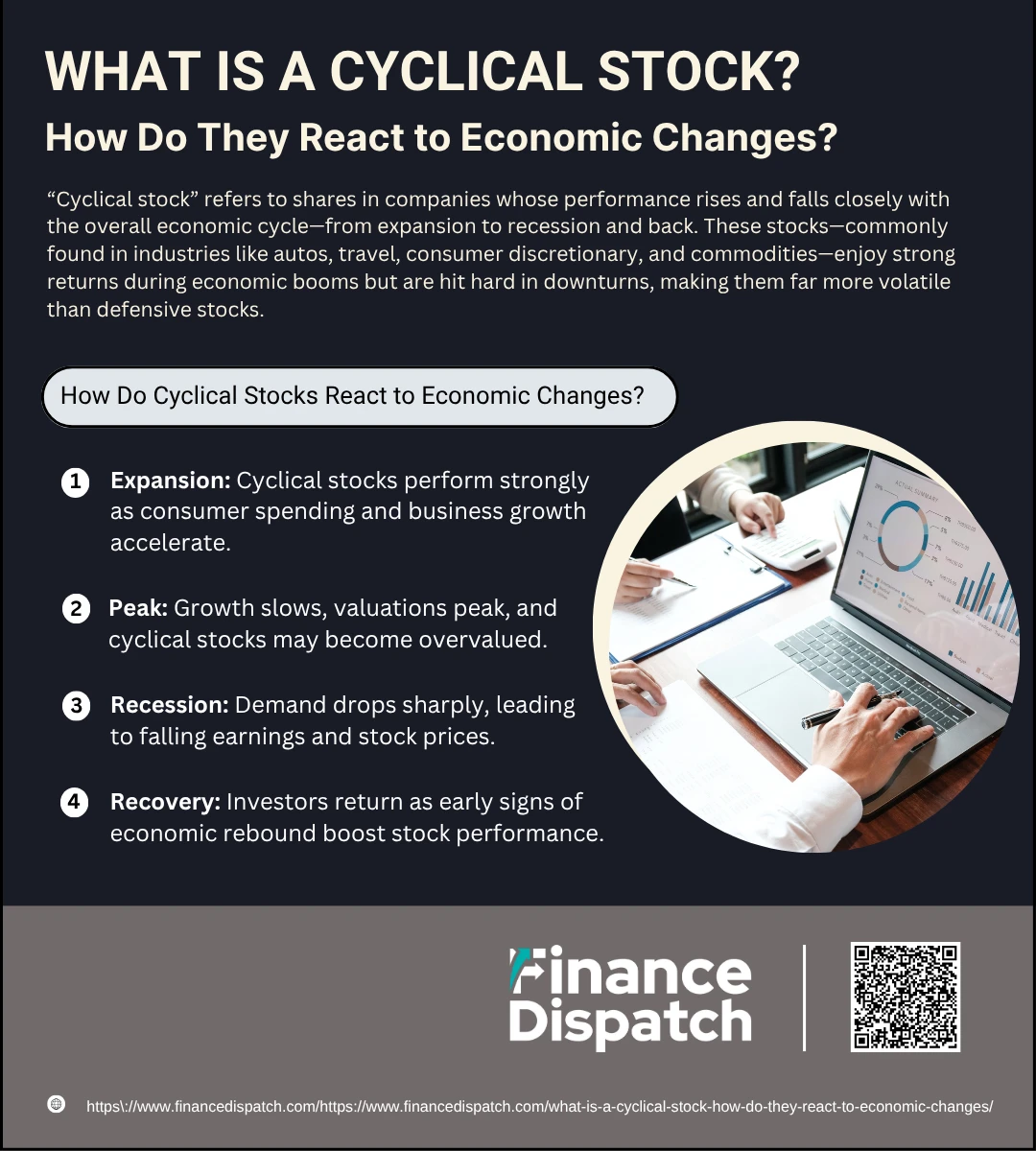 How Do Cyclical Stocks React to Economic Changes?
How Do Cyclical Stocks React to Economic Changes?
Cyclical stocks move in tandem with the health of the economy, making them highly sensitive to economic shifts. These stocks are typically linked to companies that sell non-essential goods and services—things consumers can live without when money is tight but enjoy when they feel financially secure. Because of this, the value of cyclical stocks rises and falls depending on where the economy is in the business cycle. Investors often watch economic indicators closely to determine the right moments to enter or exit these investments. Below is a breakdown of how cyclical stocks behave during each phase of the economic cycle:
1. Expansion
In this phase, the economy is growing steadily. Employment rates are high, wages are increasing, and consumer spending is robust. Cyclical companies benefit significantly during expansion as people are more confident and willing to spend on cars, vacations, electronics, home improvements, and other discretionary items. As a result, earnings rise, leading to strong performance in cyclical stocks. Sectors like travel, retail, construction, and luxury goods tend to lead the stock market during this period.
2. Peak
The peak marks the height of economic activity. While business is still good, the pace of growth starts to slow. Costs may rise due to inflation, and interest rates might increase to control overheating. At this stage, cyclical stocks may become overvalued, and their growth begins to flatten. Investors often become cautious as they anticipate the next downturn. Stock prices might remain high, but momentum begins to wane.
3. Recession
The recession phase is characterized by declining GDP, rising unemployment, and a drop in consumer and business spending. Because consumers prioritize essential purchases and cut back on luxuries, cyclical companies experience a sharp fall in demand. Profits shrink or disappear altogether, and many cyclical stocks suffer large losses. Some companies may even face bankruptcy if they’re financially unstable. Investors often sell off cyclical stocks during this time in favor of safer, non-cyclical or defensive assets.
4. Recovery
As the economy begins to bounce back, signs of improvement like lower unemployment, increased industrial activity, and growing consumer confidence emerge. Investors who anticipate the recovery often start buying cyclical stocks early—sometimes before the actual data turns positive—hoping to ride the rebound. During recovery, cyclical stocks usually outperform the market as demand for non-essential goods and services picks up again. This phase offers attractive buying opportunities for those who can identify early signs of a turnaround.
Key Differences of Cyclical vs. Non-Cyclical Stocks
To make informed investment decisions, it’s important to distinguish between cyclical stocks, which fluctuate with the economy, and non-cyclical stocks, which remain stable regardless of economic conditions. While cyclical stocks offer higher growth potential during economic booms, they also carry more risk during downturns. On the other hand, non-cyclical stocks—also known as defensive stocks—provide stability and consistent returns, making them attractive during uncertain times. The table below outlines the major differences between the two:
| Feature | Cyclical Stocks | Non-Cyclical Stocks |
| Economic Sensitivity | Highly sensitive to economic cycles | Minimal sensitivity to economic changes |
| Industry Type | Discretionary sectors (e.g., auto, travel, luxury) | Essential sectors (e.g., food, healthcare, utilities) |
| Consumer Spending Impact | Demand rises during booms and falls during recessions | Demand remains steady across all economic phases |
| Risk Level | High – volatile during downturns | Low – stable and reliable |
| Growth Potential | High during expansion periods | Moderate and steady |
| Investment Timing Importance | Critical – timing can greatly affect returns | Less dependent on timing |
| Examples | Ford, Disney, Delta Airlines | Coca-Cola, Unilever, Johnson & Johnson |
| Portfolio Role | Suited for aggressive growth and timing strategies | Ideal for risk-averse or long-term stability |
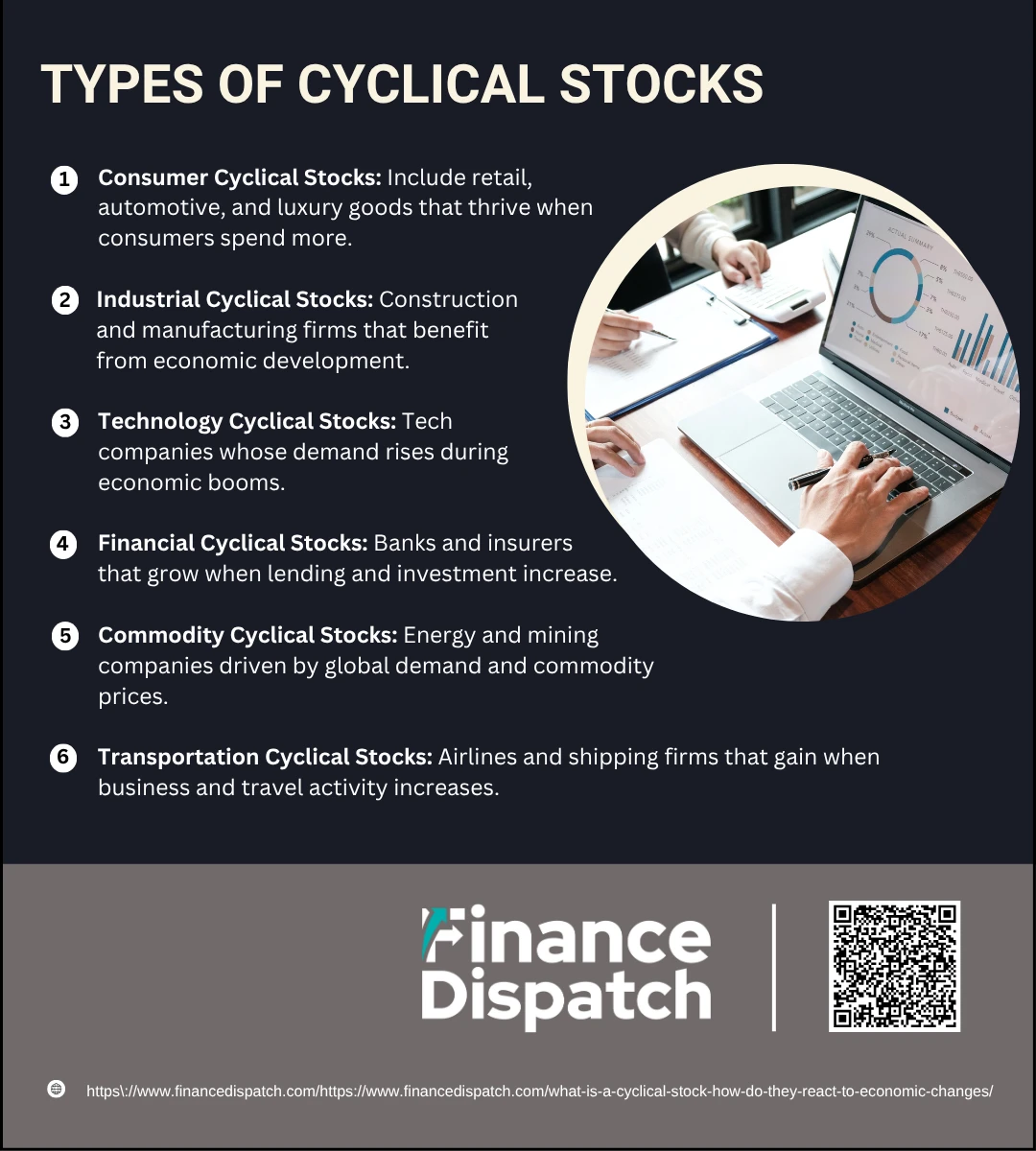 Types of Cyclical Stocks
Types of Cyclical Stocks
Cyclical stocks span a wide range of industries, but they all share one thing in common—their performance tends to rise and fall with the state of the economy. These companies typically operate in sectors that rely on consumer confidence and discretionary spending. Understanding the types of cyclical stocks can help investors identify which sectors might perform best during various phases of the economic cycle.
Here are the major types of cyclical stocks:
1. Consumer Cyclical Stocks
These include companies that sell non-essential goods and services directly to consumers. Think of industries like retail, automotive, home improvement, and luxury goods. When consumers have extra income, they tend to spend more in these areas. Examples include companies like Ford, LVMH, and Home Depot.
2. Industrial Cyclical Stocks
These stocks belong to companies in heavy industries such as construction, manufacturing, and infrastructure. Their performance improves when governments or businesses invest in development during economic growth. Notable names include Caterpillar and Boeing.
3. Technology Cyclical Stocks
Although tech is often seen as a growth sector, many companies within it—especially those in consumer electronics and enterprise software—are cyclical. Demand for new gadgets and upgrades typically rises during economic booms. Examples include Apple, Intel, and ASML.
4. Financial Cyclical Stocks
Banks, insurance companies, and investment firms are affected by interest rates and lending activity. These businesses do well during expansions when borrowing and investing increase, and struggle during recessions. Examples include JPMorgan Chase, Prudential, and HSBC.
5. Commodity Cyclical Stocks
Companies in the oil, gas, metals, and mining sectors often see their revenues fluctuate based on global economic demand. Prices for commodities like oil and copper rise when economic activity picks up. Examples include ExxonMobil, Rio Tinto, and Glencore.
6. Transportation Cyclical Stocks
Airlines, shipping companies, and logistics providers see increased demand when the economy grows. When consumer and business activity slows, so does demand for transportation. Examples include Delta Airlines, Maersk, and UPS.
Why Do Investors Buy Cyclical Stocks?
Cyclical stocks can be a powerful tool in an investor’s portfolio when used strategically. While they come with higher risk due to their sensitivity to economic cycles, they also offer the potential for substantial rewards—especially during times of economic expansion. Many investors are drawn to cyclical stocks not just for their profit potential, but also for the unique advantages they offer across different market conditions.
Here are the main reasons why investors buy cyclical stocks:
1. High Return Potential
During periods of economic growth, cyclical stocks often outperform the broader market due to increased consumer and business spending.
2. Opportunities During Recoveries
Cyclical stocks tend to rebound early in an economic recovery, giving investors a chance to capitalize on rising prices before broader growth takes hold.
3. Market Timing Benefits
Skilled investors can potentially buy low during downturns and sell high during expansions, timing the cycle to their advantage.
4. Diversification
Adding cyclical stocks to a portfolio alongside defensive stocks helps balance risk and return, especially in changing economic climates.
6. Sector-Specific Upside
Certain cyclical sectors—like technology, commodities, or industrials—may perform exceptionally well depending on where the economy is in the cycle.
7. Inflation Hedge
Some cyclical industries, particularly energy and commodities, can act as a hedge against inflation by benefiting from rising prices.
8. Long-Term Growth
Over time, well-managed cyclical companies in strong sectors can offer significant capital appreciation as economies expand.
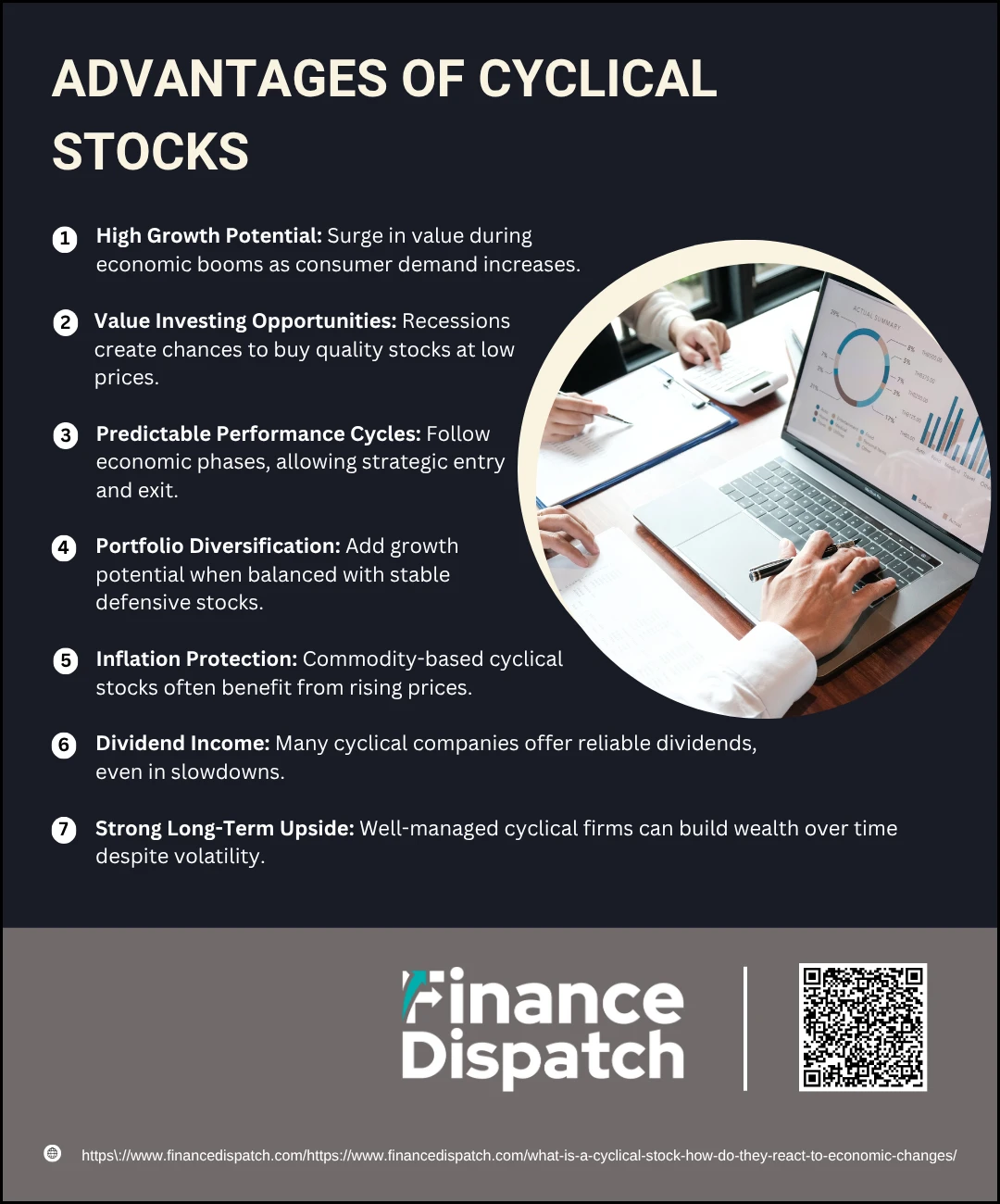 Advantages of Cyclical Stocks
Advantages of Cyclical Stocks
Cyclical stocks may not be the safest bet during economic uncertainty, but for informed investors, they offer a compelling set of benefits. These stocks are often tied to companies that thrive during periods of economic expansion—when consumers and businesses are confident, spending rises, and earnings surge. Because of their tendency to follow economic patterns, cyclical stocks can provide strategic opportunities for growth, income, and diversification when used thoughtfully within a portfolio.
Here are the key advantages of investing in cyclical stocks:
1. High Growth Potential
When the economy is expanding, consumers have more disposable income and are more likely to spend on things like cars, travel, electronics, and luxury goods. This boosts revenue and profits for companies in cyclical industries, often causing their stock prices to climb rapidly. Investors positioned early in the cycle can enjoy substantial capital gains.
2. Value Investing Opportunities
Cyclical stocks often decline sharply during recessions, not always due to poor fundamentals but because of reduced consumer demand. This creates potential buying opportunities for long-term investors who believe in the company’s recovery prospects and are patient enough to wait for the next economic upswing.
3. Predictable Performance Cycles
Because their performance tends to track the stages of the economic cycle, cyclical stocks are somewhat more predictable than other high-risk investments. Investors who follow indicators like GDP growth, unemployment trends, and consumer sentiment can often anticipate when these stocks are likely to rise or fall.
4. Portfolio Diversification
Including cyclical stocks in a portfolio alongside defensive (non-cyclical) stocks creates a more balanced mix of risk and return. While defensive stocks provide stability, cyclical stocks add dynamic growth potential, especially during bullish economic periods.
5. Inflation Protection
Sectors like energy, mining, and basic materials—which are often considered cyclical—tend to benefit from rising commodity prices during inflationary periods. These companies can pass on higher costs to consumers and maintain profitability, making them a useful inflation hedge.
6. Dividend Income
Many mature companies in cyclical sectors pay dividends, providing investors with a steady income stream. Even during slower economic phases, these dividends can offer a cushion and contribute to total returns when reinvested wisely.
7. Strong Long-Term Upside
Though cyclical stocks experience short-term volatility, those tied to fundamentally strong businesses can deliver impressive long-term gains across multiple economic cycles. Investors with a long horizon and tolerance for market swings may find these stocks valuable for building wealth over time.
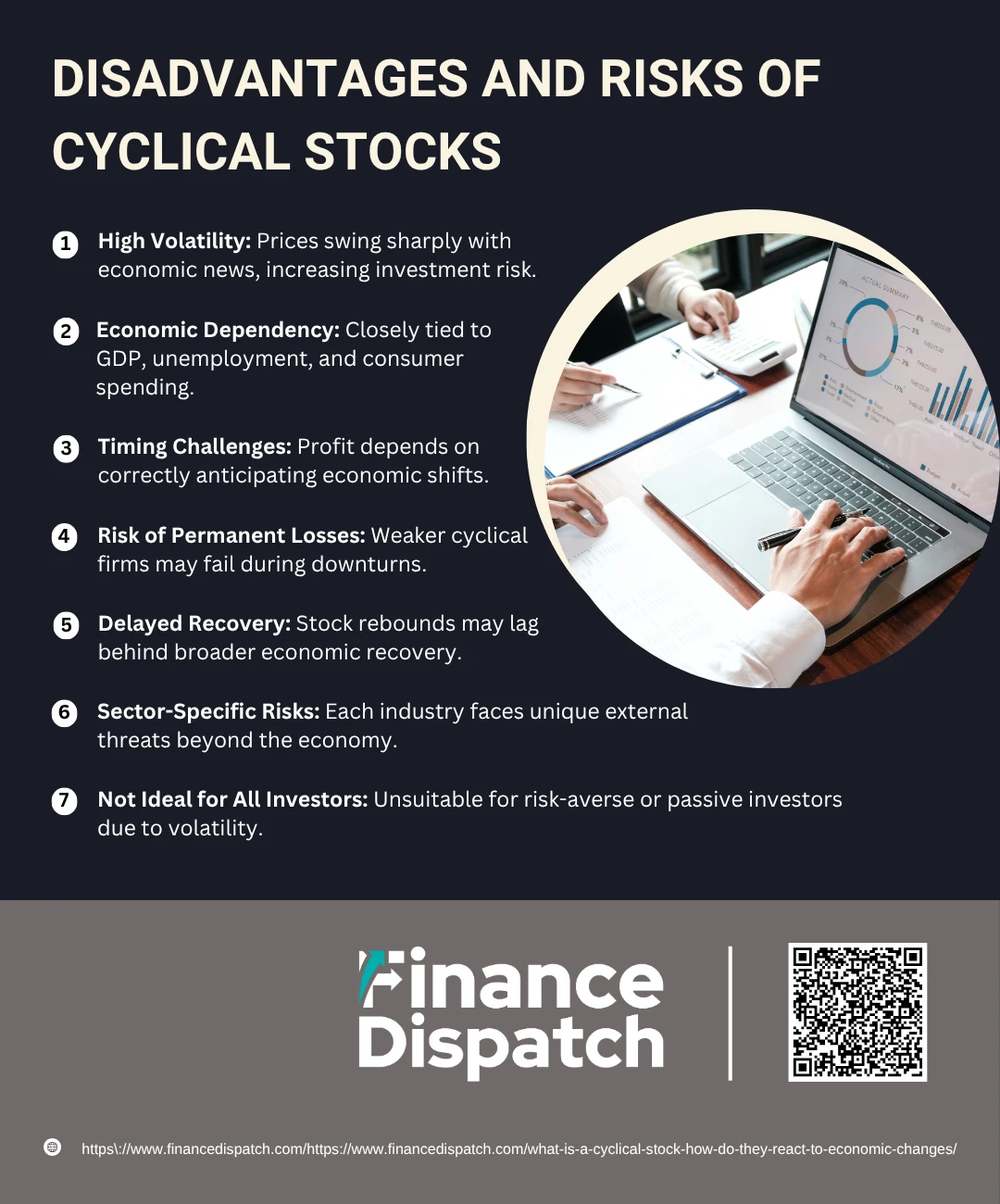 Disadvantages and Risks of Cyclical Stocks
Disadvantages and Risks of Cyclical Stocks
Cyclical stocks are appealing for their growth potential during strong economic periods, but they’re not without substantial risks. Their performance closely tracks the business cycle, which means they can just as easily fall as rise—sometimes more sharply than the market overall. For investors who are not equipped to time their entries and exits carefully, cyclical stocks can become financial traps instead of opportunities. It’s crucial to understand these risks before allocating a significant portion of your portfolio to them.
Here are the key disadvantages and risks of investing in cyclical stocks:
1. High Volatility
Cyclical stocks are known for large price fluctuations. Their value can soar during a booming economy but plummet during a slowdown or recession. This volatility creates uncertainty and can trigger emotional decision-making, leading investors to buy or sell at the wrong time.
2. Economic Dependency
These stocks are directly tied to macroeconomic performance. In times of economic distress—rising unemployment, slowing GDP, or decreased consumer spending—cyclical companies often see their revenues and profits fall quickly. This tight link to economic conditions makes them vulnerable when the broader market stumbles.
3. Timing Challenges
Profiting from cyclical stocks depends heavily on timing. Investors must recognize when the economy is shifting toward growth or decline. Unfortunately, economic turning points are often unclear in real time. Acting too early or too late can result in subpar performance or even losses.
4. Risk of Permanent Losses
Some cyclical companies carry high debt or operate on thin margins, making them particularly exposed during economic downturns. If these companies cannot weather the storm, they may go bankrupt. In such cases, investors not only lose value temporarily—they could lose their entire investment.
5. Delayed Recovery
Even after the economy begins to recover, it may take time for demand in cyclical industries to rebound. Consumer and business confidence doesn’t always return immediately. As a result, cyclical stocks might lag behind other sectors in a post-recession rally, testing investors’ patience.
6. Sector-Specific Risks
Each cyclical industry comes with unique challenges beyond economic conditions. For example, the travel industry may be affected by geopolitical tensions or health crises, while the energy sector can suffer from global oil supply fluctuations. These added risks can compound the uncertainty of investing in cyclical stocks.
7. Not Ideal for All Investors
The volatility and timing requirements make cyclical stocks unsuitable for every investor—especially those with low risk tolerance, shorter investment horizons, or limited market experience. These stocks are better suited for individuals who can actively manage their portfolio and withstand periods of underperformance.
How to Invest in Cyclical Stocks
Investing in cyclical stocks requires more than just picking companies that look promising—it demands a solid understanding of the economy, strategic timing, and disciplined risk management. Since these stocks tend to rise and fall along with economic cycles, the key to success lies in identifying where the economy is headed and positioning your investments accordingly. When done right, cyclical investing can generate substantial returns, but it also requires careful planning to avoid potential losses.
Here are some essential tips on how to invest in cyclical stocks effectively:
1. Understand the Business Cycle
Familiarize yourself with the four phases of the economic cycle—expansion, peak, recession, and recovery. Recognizing where the economy currently stands will help guide your investment decisions.
2. Follow Economic Indicators
Watch for indicators like GDP growth, unemployment rates, consumer confidence, and interest rates. These can signal when to enter or exit cyclical investments.
3. Time Your Entry and Exit Carefuly
Buy cyclical stocks during or near the end of a recession, when prices are low, and sell during the late stages of economic expansion, when valuations are high.
4. Diversify Across Sectors
Don’t concentrate all your capital in one cyclical industry. Spread your investments across different sectors (e.g., travel, automotive, construction) to reduce risk.
5. Choose Financially Sound Companies
Focus on companies with strong balance sheets, low debt, and healthy cash flow. These businesses are more likely to survive downturns and thrive during recoveries.
6. Look for Insider Buying
Watch for signs of executives purchasing their own company’s shares. This often signals management’s confidence in the company’s future.
7. Avoid Relying on P/E Ratios Alone
Since cyclical earnings fluctuate, traditional metrics like price-to-earnings (P/E) can be misleading. Consider using price-to-book (P/B) ratios or cash flow analysis instead.
8. Set a Risk Management Plan
Use tools like stop-loss orders to limit potential losses, and decide in advance how much you’re willing to risk on each position.
9. Monitor Market Trends Regularly
Stay updated on global and industry-specific news that may affect your investments. Cyclical stocks react quickly to economic changes and require ongoing attention.
10. Balance with Non-Cyclical Stocks
Combine cyclical stocks with defensive or non-cyclical stocks in your portfolio to maintain stability through all economic conditions.
Real-World Examples of in Cyclical Stocks
Cyclical stocks are all around us, often tied to the goods and services people buy when the economy is thriving—and cut back on when times are tough. From cars and airlines to luxury brands and home appliances, these companies serve as real-world indicators of consumer confidence and economic health. Looking at actual companies that fall under the cyclical category can help investors better understand how these stocks behave in response to economic changes.
Here are some well-known examples of cyclical stocks from various industries:
1. Ford Motor Company (Automotive Sector)
Demand for new vehicles increases when consumers feel financially secure, making car manufacturers like Ford a classic example of cyclical behavior.
2. Delta Air Lines (Travel & Transportation)
Travel is a discretionary expense. Airlines often see booming business during economic growth but suffer sharp declines during recessions.
3. LVMH (Luxury Goods)
The maker of brands like Louis Vuitton and Moët & Chandon thrives when consumers are flush with disposable income and willing to splurge on high-end items.
4. The Walt Disney Company (Entertainment)
Disney’s revenue from theme parks, movies, and streaming services grows during economic booms, but slows when households cut leisure budgets.
5. Caterpillar Inc. (Construction Equipment)
A major player in construction and mining machinery, Caterpillar’s earnings grow with increased infrastructure and industrial activity during economic upturns.
6. ExxonMobil (Energy & Commodities)
As a global oil and gas giant, ExxonMobil’s performance is heavily tied to commodity prices, which usually rise during strong economic activity.
7. Apple Inc. (Consumer Electronics)
While widely regarded as a tech leader, Apple’s reliance on consumer spending for premium electronics makes it sensitive to economic fluctuations.
8. UPS (Logistics & Shipping)
Shipping and logistics demands rise during periods of strong economic activity as both e-commerce and commercial supply chains ramp up.
Who Should Consider Cyclical Stocks?
Cyclical stocks are best suited for investors who are comfortable with market fluctuations and have a solid understanding of economic trends. These investors should be willing to monitor the business cycle closely and time their investments to maximize gains during periods of economic expansion. Ideal candidates include growth-oriented investors with a medium- to long-term horizon, those who can tolerate short-term volatility, and individuals looking to actively manage their portfolios. While not typically recommended for very conservative or income-focused investors, cyclical stocks can play a valuable role for those seeking higher returns and willing to accept the associated risks. Diversification and proper risk management are key when including these stocks in any investment strategy.
Conclusion
Cyclical stocks offer a dynamic opportunity for investors to capitalize on the natural ebb and flow of the economy. While they can deliver impressive returns during periods of economic growth, they also come with heightened risks during downturns. Understanding how these stocks react to different phases of the business cycle is essential for making informed investment decisions. By recognizing the industries they operate in, monitoring economic indicators, and applying sound risk management strategies, investors can harness the potential of cyclical stocks to enhance portfolio performance. However, success with these investments requires patience, timing, and a balanced approach that includes both cyclical and non-cyclical holdings.



